
by Greg Sharp
He was simply a mechanical genius. He has been called "The Father of Hot Rodding" and the "Founder of American Race Technology." He was all that and more. Edward Arnold Winfield was born October 4, 1901 northeast of Los Angeles and coincidentally grew up with the automobile. By age 7 he had compiled an enormous collection of car catalogs from which he first learned what made cars run. At age eleven, he stripped off the body of the family Model T and got it up to 60 mph. By twelve he had completed his formal education; the eighth grade. Their father died when Ed was five and he and his younger brother Bud were raised by their mother. He hoped to go to the YMCA technical school in Los Angeles, but there was no money. Instead, he talked them into chasing parts on his bicycle in exchange for tuition.
At fourteen, Ed joined the great Harry A. Miller working in the carburetor department for $.60 per hour. It was the perfect setting for the budding genius. His quick learning ability soon moved him into the machine shop making parts for Miller racing engines. Miller's tyrannical style soon wore on young Winfield and although offered a ten cent raise, he moved on. At age sixteen using hand tools, he changed the duration of the cams in his one cylinder motorcycle, filed .020 off the head and opened the intake port. He remarked "I could climb any mountain road around here in high gear!"
He rode in his first race at Ascot Speedway in Los Angeles in 1917. His friend Fred Frame (1932 Indy 500 champion) entered a special race for Model T's and asked Winfield to serve as riding mechanic. The AAA rules required all competitors to be twenty-one. Winfield, just past his sixteenth birthday, was well over six feet two and 180 pounds. "As far as I know, I was the only registered sixteen-year-old mechanician in existence!"
In 1919 Ed obtained a used grinding machine which he converted to a cam grinder, and that same year scratch-built his first carburetor. By the early '20s The Winfield Carburetor Company was thriving and few Indianapolis winners drew air through anything other than a Winfield carburetor until the dawn of fuel injection in the early '50s.
He drove his own flathead Model T racers on dirt tracks throughout California. In 1924 he won a match race and the trophy for "World's Fastest Ford". Winfield's tremendous mechanical understanding told him of flaws in the Model T's layout. He made a billet crankshaft and redesigned the camshaft to change the firing order, thereby charging all cylinders equally. His "Two Up and Two Down" racer showed its bobbed tail to the Frontenacs and Millers at Ascot in January 1928.
Ed's marriage and ever increasing speeds saw him leave the cockpit shortly thereafter to concentrate his colossal mind on making speed and power for others. In 1934 he designed his only overhead valve head as a conversion for the Ford Model B. Young Rex Mays drove Paul Fromm's "Winfield Special" sprint car to the Pacific Coast Championship.
In the 1930s, if you had a Winfield head, cam, or carburetor, or better yet all three, you were the man to beat. The activity that became known as hot rodding grew on the California dry lake beds, yet Winfield never set foot on them. Instead, he chose to stay home and work on his designs. He was shy and nearly reclusive. Customers of his shops in Los Angeles and later San Francisco reported no identification on the building, and that if you knocked he might open the door about six inches or he might not. Eventually your camshaft would be passed out the door wrapped in paper.
Paradoxically Winfield developed the simple Model T Ford into a winning racer and together with Bud, Leo Goosen and Fred Offenhauser produced the most complex racing engine of its day, the legendary dual overhead cam supercharged Novi.
In later years, the Winfield genius wasn't wasted. In 1962 when Ford Motor Company began developing their DOHC V-8 initial performance was disappointing. They flew an engine and two project engineers to Las Vegas where Winfield lived out his years. After barely a glance, he redesigned the intake ports and valve sizes and the engine immediately began to reach its potential.
As late as 1976, Winfield, well into his seventies, received a letter from chief mechanic George Bignotti asking him to regrind the cams for his latest Indy 500 entry. Ed spent much of his later years studying Einstein's Theory of Relativity and believed he had found its flaws. He died quietly leaving no survivors on April 15th, 1982.